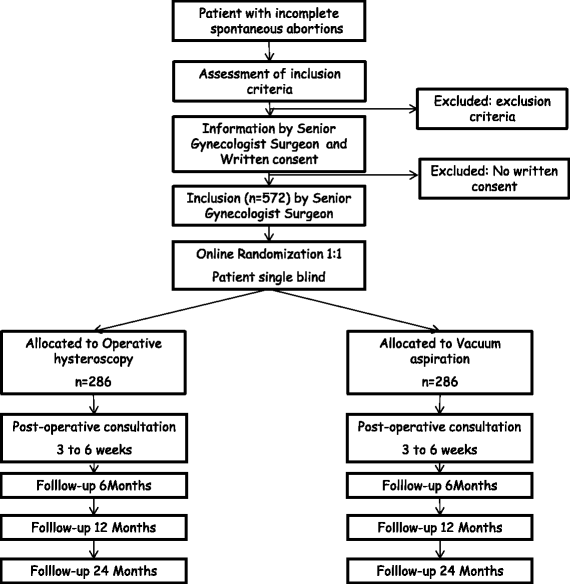Operative hysteroscopy versus vacuum aspiration for incomplete spontaneous abortion (HY-PER): study protocol for a randomized controlled trial
- PMID: 26282937
- PMCID: PMC4539935
- DOI: 10.1186/s13063-015-0900-1
Operative hysteroscopy versus vacuum aspiration for incomplete spontaneous abortion (HY-PER): study protocol for a randomized controlled trial
Abstract
Background: Incomplete spontaneous abortions are defined by the intrauterine retention of the products of conception after their incomplete or partial expulsion. This condition may be managed by expectant care, medical treatment or surgery. Vacuum aspiration is currently the standard surgical treatment in most centers. However, operative hysteroscopy has the advantage over vacuum aspiration of allowing the direct visualization of the retained conception product, facilitating its elective removal while limiting surgical complications. Inadequately powered retrospective studies reported subsequent fertility to be higher in patients treated by operative hysteroscopy than in those treated by vacuum aspiration. These data require confirmation in a randomized controlled trial comparing fertility rates between women undergoing hysteroscopy and those undergoing vacuum aspiration for incomplete spontaneous abortion.
Methods: After providing written informed consent, 572 women with incomplete spontaneous abortion recruited from 15 centers across France will undergo randomization by a centralized computer system for treatment by either vacuum aspiration or operative hysteroscopy. Patients will not be informed of the type of treatment that they receive and will be cared for during their hospital stay in accordance with standard practices at each center. The patients will be monitored for pregnancy or adverse effects by a telephone conversation or questionnaire sent by e-mail or post over a period of two years. In cases of complications, failure of the intervention or diagnosis of uterine cavity disease, patient care will be left to the discretion of the medical center team.
Discussion: If our hypothesis is confirmed, this study will provide evidence that the use of operative hysteroscopy can increase the number of pregnancies continuing beyond 22 weeks of gestation in the two-year period following incomplete spontaneous abortion without increasing the incidence of morbidity and peri- and postoperative complications. The standard surgical treatment of this condition would thus be modified. This study would therefore have a large effect on the surgical management of incomplete spontaneous abortion.
Trial registration: ClinicalTrials.gov Identifier: NCT02201732 ; registered on 17 July 2014.
References
-
- Friedler S, Margalioth EJ, Kafka I, Yaffe H. Incidence of post-abortion intra-uterine adhesions evaluated by hysteroscopy − a prospective study. Hum Reprod. 1993;8(3):442–4. - PubMed
-
- Golan A, Schneider D, Avrech O, Raziel A, Bukovsky I, Caspi E. Hysteroscopic findings after missed abortion. Fertil Steril. 1992;58(3):508–10. - PubMed
Publication types
MeSH terms
Associated data
LinkOut - more resources
Full Text Sources
Other Literature Sources
Medical


